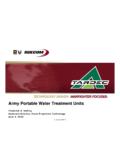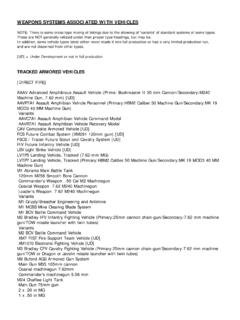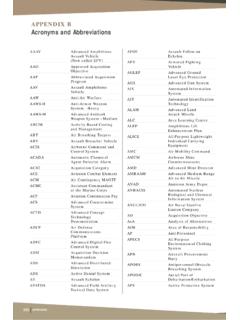Transcription of I NUCLEAR NOTES NUMBER 8 - Defense Technical …
1 I. NUCLEAR NOTES NUMBER 8. NUMBER EIGHT INASERIES OF INFORMATION PAPERS ON TOPICS. C: ASSOCIATED WITH NUCLEAR WEAPONS, PRINCIPALLY DESIGNED FOR USE. BY TRADOC SCHOOL INSTRUCTORS AND MAJOR COMMAND STAFF OFFICERS. ,! AN. -AI R. : ;i UoS. ARMY NUCLEAR AND CHEMICAL AGnENCY. ;.. ,,,. ,.. ,: : FORT BELVOIR, VIRGINIA 22060 .., May 1979. FOREWORD. The series of papers, " NUCLEAR NOTES ," prepared by the US Army NUCLEAR :nd Chemical Agency is intended to clarify and explain various anspects of NUCLEAR weapons phenomenology and usage. These papers are prepared in as nontechnical a fashion as the subject ma ter permits. They are oriented toward an audience that is involved with teaching, learning or applying the tactics and techniques of employing NUCLEAR weapons in a conflict situation.
2 Sufficient illustrations are provided to ;flow instructors or briefers to develop suitable vu-g'aphs. The dissemination of these NUCLEAR NOTES will hopefully provide to the US Army accurate, up-to-date information of importance in understanding the use of NUCLEAR weapons on the battlefield. The principal author of this paper is Dr. Charles N. Davidson of the US Army NUCLEAR and Chemical Agency. Comments and views of readers are desired and should be forwarded to Commander, US Army NUCLEAR and Chemical Agency, 7500 Backlick Road, Bldg. 2073, Springfield, VA 22150. DONALD F. PANZER. COL, FA. Deputy Commander I2. 1I. j A.. ,.. T. , ]: .TC,r: F2.
3 " "9. ;4:'J. 'Ha S .. '. D iM.. ' . ! ! }.. 'f, "..,,',W :: . : ,:. L .., I- -". Tne US Army NUCLEAR and Chemical Agency that issues of NUCLEAR NOTES be retained and filed in a loose leaf hinder. issues are: NUCLEAR NOTES NUMBER 1 - The Electromagnetic Pulse (EMP), June 1974. NUCLEAR NOTES NUMBER 2 - The Army NUCLEAR Survivability P-ogram, October 1974. NUCLEAR NOTES NUMBER 3 - The New NUCLEAR Radiation Casualty Criteria, May 1975. NUCLEAR NOTES NUMBER 4 - NUCLEAR Blackout of Tactical Communications, August 1976. NUCLEAR NOTES NUMBER 5 - Rainout, December 1976. NUCLEAR NOTES NUMBER 6 - A Primer on NUCLEAR Weapons Capabilities, June 1977. NUCLEAR NOTES NUMBER 7 - Collateral Damage, April 1978.
4 Local reproduction and distribution are authorized; however, headquarters that do so are requested to maintain a record of internal distribution so that changes, up-dates, and corrections may be properly disseminated. -. ~ C. pr! ARMORED VEHICLE SHIELDING AGAINST RADIATION. INTRODUCTION. NUCLEAR weapons may be used at any on the tactical battlefield. The ability to operate ffectively in such an environment and to employ NUCLEAR weapons with confidence requires a knowledge of the protection provided crew members by representative US and Soviet armor. An understanding of the operational advantages to be gained from shielding improvements is also important.
5 This note will suimarize the shielding which armored vehicles provide against residual nurlear radiation, initial NUCLEAR radiation, and neutron induced radioactivity in the tank armor itself; and will highlight the payoffs associated with improving this shielding. WHAT APPROACH IS TAKEN? In summarizing existing protection, the radiation shielding provided by the Soviet and US medium tanks, light tanks or assault vehicles, and armored personnel carriers listed in Figure 1 will be compared. The listed vehicles are the most recent for Which unclassifieo data are available. Although interest in the radiation protection provided by vehicles of these two nations derives from different considerations -- defensive (friendly troop vulnerability) for US vehicles and offensive (weapon employment effectiveness) for Soviet vehicles -- making direct comparisons is an effective way to appreciate the relative.
6 Advantages possessed by either nation. HOW IS RADIATION PROTECTION EXPRESSED? The shielding provided by a vehicle against radiation is expressed in terms of a "transmission factor" or "TF". This transmission factor can be defined simply as the dose received by crew members inside the vehicle, divided by the dose which would be received outside the vehicle. Or, in other words, the TF represents the fraction of tne outside dose transmitted into the vehicle (Figure 2). (Some documents refer instead to a "protection factor" or "PF". The PF is the reciprocal of the TF.). WHAT PROTECTION DO ARMORED VEHICLES PROVIDE AGAINST RESIDUAL RADIATION? Residual radiation includes both fallout and neutron induced radiation in the soil.
7 Fallout consists principally of gamma rays emitted from fission products which have been deposited on the ground following a surface or near-surface NUCLEAR burst. Neutronu induced radiation consists of gamma rays emitted from soil particles in the ground made radioactive by neutrons from air' or surface bursts. As indcated in Figure 3, the radiation from either arrives from all directions. Although there is some variation in tne protection provided to different crew members in the same vehicle, these variations are generally small enough to be ignored. The residual radiation protection provided by Soviet and US vehicles is shown in Figures 4, 5 and 6.
8 There is very high confidence in the validity of these residual radiation transmission factors. Figure 4 compares the protection provided by medium tanks. The NUMBER on each vehicle is the transmission factor. For example, a TF of .04 means that, for every 100 rads of residual gamma radiation incident on the outsiae of the tank, only 4 rads are received by crew members inside. Two conclusions are immediately evident: first -- both Soviet and US. medium tanks provide comparable residual radiation shielding; and second -- this shielding "is excellent since, in crossing a -adiation field, tank crews would receive only 3. to 4% of the radiation dose received by unprotected troops crossing at the same speed.
9 Of course, this assumes that little radioactive dust gets inside the tank to remain the-e after the field is crossed. Such an occuorence could be avoided only by some type of air filtration or positive pressurization system for the vehicle. Tanks with such R system could possess a marked advantage in traversing contaminated areas, particularly if dry and dusty conditions exist. The comparison of TFs for lighter tanks or assault vehicles Ls shown in Figure 5. Although these two vehicles do not perform iderntical functions and are thus not st-ictly US SOVIET. MEDIUM TANKS. M60AI T-55. M60A2 T-62. LIGHT TANKS/ASSAULT VEHICLES. M551 PT-76. APCs M113A1 BTR-50.
10 ( LATEST FOR WHCH PAT ARE AVAILADLE). FIG. 1-ARMORED VEHICLES COMPARED *. INSIDE DOSE. TF= *"'-------- OUTSIDE DOSE. FIG. 2-TRANSMISSION FACTOR. ?2. FIG. 3-RESIDUAL RADIATION. Ius SOVIET. M6OA1 To55. 2ii M60A2 T-62. FIG. 4-RESIDUAL TUs (MEDIUM TANKS). ~jjlilt " , US SOVIET. M551 PT-76. FIG. 5-RESIDUAL TFs (LT TANKS/ASSAULT VEHICLES). US SOVIET. M113AI FIG. 6-RESIDUAL TFs IAPCs). 4. 'I' - comparable, they do illustrate the fact that crews of such vehicles are about 5 to 10 times more vulnerable than crews in medium tanks. As shown in Figure 6, the residual radiation shielding provided by these lighter vehicles does not differ significantly from that provided by APCs.















